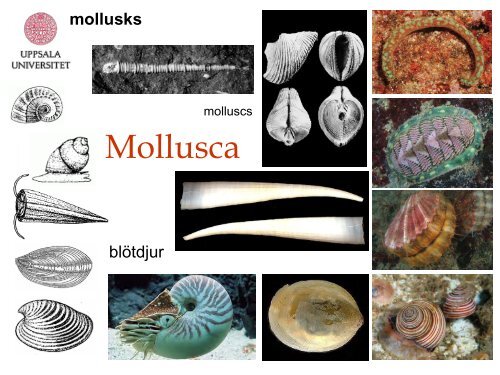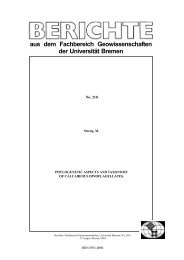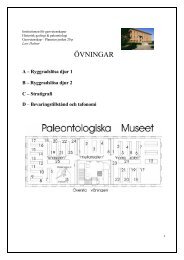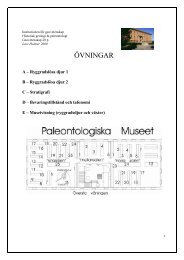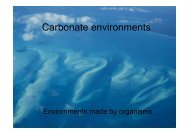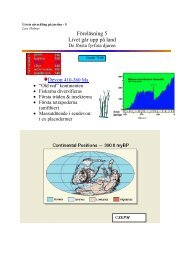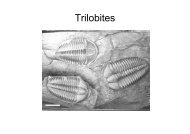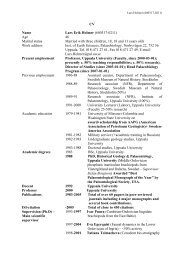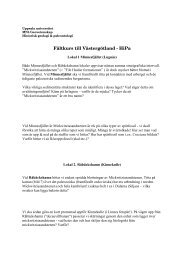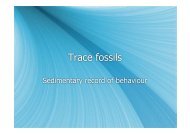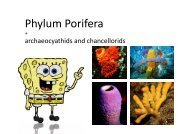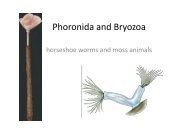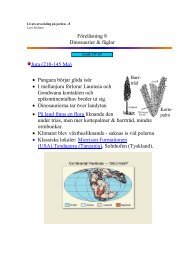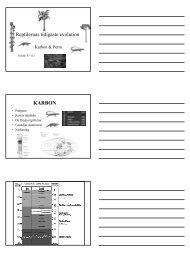Mollusca
Mollusca
Mollusca
Create successful ePaper yourself
Turn your PDF publications into a flip-book with our unique Google optimized e-Paper software.
mollusks<br />
<strong>Mollusca</strong><br />
blötdjur<br />
molluscs
What is a mollusc?<br />
Fundamental organization (hypothetical archimollusc):<br />
- shell secreted by a layer of tissue called the mantle<br />
- mouth and anus at opposite end (but in gastropods both anterior)<br />
- mantle cavity bears gills (but pulmonate gastropods have no gills)<br />
- above mantle cavity is the visceral mass<br />
with gut, nervous, circulatory and muscular system<br />
- shell is of calcium carbonite (calcite or aragonite) (but may be secondaryly lost)<br />
- shell typically external (but in some groups it became internal)<br />
- grow by accretion (calcium carbonate is added to the edge of the shell by the mantle)<br />
- generally marine (but also few freshwater terrestrial groups)<br />
<strong>Mollusca</strong>
systematics main groups<br />
<strong>Mollusca</strong>
Bivalvia<br />
<strong>Mollusca</strong> – systematics – Bivalvia
Bivalvia (=Pelecypoda, Lamellibranchia)<br />
pair of valves (right and left valve)<br />
bilobed mantle<br />
valves articulate along a dorsal hinge line<br />
no head<br />
typically bilaterally symmetric<br />
(plane of symmetry passing between the valves, = commissural plane)<br />
prominent ventral foot<br />
known since the Early Cambrian, but diversify not prior to Ordovician<br />
but still not a very common faunal element during the Paleozoic<br />
<strong>Mollusca</strong> – systematics – Bivalvia
Main features of the shell<br />
muscle scars ligament dentition lunule pallial line beak<br />
homomyar internal cardinalia (escutcheon) sinupalliate orthogyrate<br />
heteromyar external lateralia integripalliate prosogyrate !<br />
monomyar amphidetic opisthogyrate<br />
prosodetic<br />
opisthodetic !<br />
<strong>Mollusca</strong> – systematics - Bivalvia
Basic for systematics are the gill type and the hinge dentition<br />
Gills: Protobranchs (deposit feeders, most primitive)<br />
Filibranchs (suspension feeders)<br />
<strong>Mollusca</strong> – systematics – Bivalvia – gill types<br />
Eulammelibranchs (suspension feeders)<br />
Septibranchs (carnivores, most derived)
Dentition: Various types and subtypes<br />
taxodont – dysodont – isodont – schizodont – desmodont – pachydont – heterodont<br />
<strong>Mollusca</strong> – systematics – Bivalvia – dentition
Types of dentition<br />
Taxodont – many small similar teeth & sockets all along hinge plate (e.g., Glycimeris and Arca)<br />
Schizodont – two or three thick teeth with prominent grooves (e.g., Trigonia)<br />
Dysodont – small simple teeth near the edge of the valve (eg Mytilus)<br />
Heterodont – few teeth varying in size and shape, distinquished as cardinal teeth, beneath the umbo, and<br />
lateral teeth which lie obliquely along the hinge plate (e.g., most recent bivalves)<br />
Isodont – teeth very large and located on either side of a central ligament pit (e.g., Spondylus)<br />
Desmodont – teeth very reduced or absent (e.g., Mya) with a large internal process (the chondrophore)<br />
carrying the ligament<br />
<strong>Mollusca</strong> – systematics – Bivalvia – dentition
taxodont<br />
Taxodont – many<br />
small similar teeth &<br />
sockets all along hinge<br />
plate (e.g., Glycimeris<br />
and Arca)
Dysodont –<br />
small simple<br />
teeth near the<br />
edge of the<br />
valve (eg<br />
Mytilus)<br />
dysodont<br />
no teeth just crenulation
heterodont<br />
Heterodont – few teeth varying in size and shape, distinquished as cardinal teeth,<br />
beneath the umbo, and lateral teeth which lie obliquely along the hinge plate (e.g.,<br />
most recent bivalves)<br />
cardinalia and lateralia
Isodont –teeth<br />
very large and<br />
located on either<br />
side of a central<br />
ligament pit (e.g.,<br />
Spondylus)<br />
isodont<br />
two teeth correspond to two grooves
schizodont<br />
Schizodont – two or three thick teeth with prominent grooves (e.g., Trigonia)<br />
teeth have crenulations (”teeth with teeth”)
desmodont<br />
Desmodont – teeth very reduced or absent (e.g., Mya) with a large internal<br />
process (the chondrophore) carrying the ligament<br />
internal process (the chondrophore) carries the ligament
pachydont<br />
Pachydont – large, heavy and massive teeth (e.g., rudists)
Orientation of a bivalve shell<br />
what is posterior – anterior – right – left ?<br />
ligament typically posterior<br />
posterior adductor muscle scar stronger developed<br />
pallial sinus posterior / shell gaps posterior<br />
posterior part of shell typically better developed<br />
umbo (beak) typically points anterior (prosogyre)<br />
byssal notch anterior<br />
Oysters: left valve bigger/cemented<br />
<strong>Mollusca</strong> – systematics – Bivalvia – orientation
ight<br />
<strong>Mollusca</strong> – systematics – Bivalvia – orientation
ight<br />
<strong>Mollusca</strong> – systematics – Bivalvia – orientation
ight<br />
<strong>Mollusca</strong> – systematics – Bivalvia – orientation
ight<br />
<strong>Mollusca</strong> – systematics – Bivalvia – orientation
left<br />
<strong>Mollusca</strong> – systematics – Bivalvia – orientation
Ecology<br />
marine and fresh water<br />
typically benthic, infaunal or epifaunal<br />
include burrowing, browsing, cemented, free lying, swimming, boring forms<br />
filter feeders, deposit feeders, carnivores<br />
<strong>Mollusca</strong> – systematics – Bivalvia – ecology
Infaunal bivalves<br />
Both detrivorous and filtering strategies<br />
Most Palaeozoic groups are infaunal detrivores<br />
Probably the oldest of all bivalve life-modes<br />
Burry thorugh sediment with the muscular foot<br />
Extensions of the mantle (siphons) allow water<br />
transport<br />
Shell modified to specific substrate requirements
Infaunal bivalves<br />
Water<br />
Sediment<br />
Venus is a shallow burrowing<br />
form with short retractable<br />
siphons.<br />
Shell Features (shallow<br />
burrowers):<br />
• Equivalved<br />
• Thick(ish) valves<br />
• Adductor muscles<br />
roughly equal in size<br />
• Commonly with<br />
strong external<br />
ornament<br />
Internal view<br />
of right valve<br />
Note difference in<br />
size of pallial sinus<br />
between the two<br />
bivalves. (Generally<br />
the bigger the<br />
indentation the<br />
bigger the siphon<br />
and consequently<br />
the deeper the<br />
bivalve could<br />
burrow)<br />
Mya arenaria is a<br />
sluggish bivalve<br />
which burrows quite<br />
deeply in firm sand<br />
or mud. Its long<br />
siphons can be<br />
retracted, but not all<br />
the way back into the<br />
shell<br />
Internal<br />
view of<br />
left valve<br />
Foot<br />
Water<br />
Sediment<br />
Shell features<br />
(deeper<br />
burrowers):<br />
• Generally more<br />
elongate shells<br />
• Some have<br />
gapes in the shell<br />
commissure to<br />
allow siphons to<br />
remain outside<br />
when shell is<br />
closed<br />
• Dentition<br />
reduced
Sessile Epibenthic bivalves<br />
Attaches to hard subsrates and becomes immobile<br />
Many groups have evolved this lifemode independently<br />
Allows effective filterfeeding<br />
Mytilus (common blue mussel) and many others attach<br />
by chitinous threads (byssus) secreted by the foot<br />
Oysters attach by cementing one valve (left) to the<br />
substrate and adapt to the shape of the substrate
Motile epibenthic bivalves<br />
Lie exposed on the seabed<br />
Mostly filterfeeders<br />
Acute sensory system including photophores (eyes) and<br />
sensory tentacles along the mantle edge<br />
Escape strategy: Rapid closure of the valves creates<br />
jetstream and the mussel can thus swim short distances<br />
Some Jurassic bivalves may have been permanent<br />
swimmers
Soft sediment recliners and mudstickers<br />
Some byssally and cementing forms have<br />
evolved secondary soft sediment life-modes<br />
Larvae attaches to small objects and develops<br />
shapes that allows the bivalve to survive on the<br />
sediment surface<br />
Gryphaea (devils toenail)<br />
Pinnate bivalves
Reef-forming bivalves<br />
Rudists (Jurassic-Cretaceous) reef builders<br />
Differential valves<br />
Cone-shaped right valve<br />
Left valve acts as a lid<br />
Probably had symbiotic algae like modern<br />
Tridacna<br />
Evolved from oysters?<br />
Modern Tridacna clam
Reef-forming bivalves
Reef-forming bivalves
Rock boring bivalves<br />
Several groups of bivalves can produce<br />
livingchambers by boring through rock and wood<br />
Lithophaga<br />
calcareous substrates (corals, limestone<br />
etc.)<br />
Valves without gape<br />
Exclusively chemical excavation<br />
Pholadids<br />
All types of substrates<br />
Wood, corals, granite, lead cables, plastic,<br />
amber etc.<br />
Valves with wide anterior gape<br />
Excavation by movement (abrasion)<br />
Shell ornament of teeth and rockfragments<br />
wedged between them act as ”sandpaper”
Cephalopoda<br />
<strong>Mollusca</strong> – systematics – Cephalopoda
Cephalopods<br />
most highly evolved molluscs (especially eyes and brain)<br />
a high level of cephalization (concentration of sensory and neural centers in the head)<br />
group includes the modern Nautilus, argonauts, squids, octopuses, cuttlefishes<br />
as well as the fossil ammonites and belemnites<br />
2 main groups: Palcephalopoda (nautilids and endoceratids)<br />
Neocephalopoda (orthoceratids, ammonites, belemnites)<br />
typically bilaterally symmetrical<br />
shell, if developed, subdivided in chambers by septae<br />
chambers are connected by a tube (siphuncle)<br />
hyponome and tentacles are homologue to foot of bivalves and gastropods<br />
mouth with powerful horny beaklike jaws and a radula<br />
radula less developed than in gastropods<br />
since Late Cambrian<br />
<strong>Mollusca</strong> – systematics – Cephalopoda
Neocephalopods<br />
Spirula<br />
Loligo (Squid)<br />
Octupus<br />
Sepia (Cuttlefish)
Shell remains
Palcephalopoda (Nautilus + fossils)
Shell terminology<br />
shell wall<br />
peristome<br />
aperture<br />
growth line<br />
septum<br />
camera /<br />
chamber<br />
septal neck<br />
<strong>Mollusca</strong> – systematics – Cephalopoda – shell morphology<br />
phragmocone living chamber<br />
protoconch
<strong>Mollusca</strong> – systematics – Cephalopoda – morphology – shell
The suture = junction between septa and shell wall<br />
- most important for taxonomy and phylogeny of Ammonitoidea<br />
- particular types characterize distinct families and orders<br />
saddles: point in apertural direction<br />
lobes: point backward<br />
prosuture – primary suture<br />
<strong>Mollusca</strong> – systematics – Cephalopoda – morphology – shell
Shape of shell<br />
<strong>Mollusca</strong> – systematics – Cephalopoda
The cephalopod jaw<br />
Modern Cephalopods have a horny beak, either two simple plates or more<br />
complex structures<br />
There is also a radula with rel. simple, undifferentiated teeth
<strong>Mollusca</strong> – systematics – Cephalopoda – morphology – shell
Classification<br />
Old: Nautiloidea – Ammonoidea – Coleoidea<br />
Palcephalopoda (~Nautiloidea) – Neocephalopoda (Orthoceratoidea, Ammonoidea, Coleoidea)<br />
Palcephalopoda<br />
shell well developed and large, originally slightly curved<br />
siphuncle was situated between the center and the ventral surface.<br />
siphuncle generally large with internal deposits (important tax. feature)<br />
Neocephalopoda<br />
siphuncle thin and empty<br />
phragmocone originally straight with the siphuncle situated at or near the center<br />
later the position of the siphuncle shifted to the ventral surface (Bactritida),<br />
the shell became coiled (Ammonoidea)<br />
the shell became internal, reduced or absent (Coleoidea)<br />
<strong>Mollusca</strong> – systematics – Cephalopoda
Palcephalopoda (= Nautiloidea, + several Paleozoic groups, excl. orthoceratids)<br />
<strong>Mollusca</strong> – systematics – Cephalopoda
Neocephalopoda (= Orthoceratoidea, Ammonoidea, Coleoidea)<br />
<strong>Mollusca</strong> – systematics – Cephalopoda<br />
Ammonoidea - Goniatitida
Neocephalopoda (= Orthoceratoidea, Ammonoidea, Coleoidea)<br />
<strong>Mollusca</strong> – systematics – Cephalopoda<br />
Ammonoidea - Ammonitida
Neocephalopoda (= Orthoceratoidea, Ammonoidea, Coleoidea)<br />
Choristocerataceae<br />
Late Jurassic<br />
Spirocerataceae<br />
Middle Jurassic<br />
<strong>Mollusca</strong> – systematics – Cephalopoda<br />
Ammonoidea – heteromorphic ammonites<br />
Ancyloceratina<br />
latest Jurassic to end Cretaceous
Neocephalopoda (= Orthoceratoidea, Ammonoidea, Coleoidea)<br />
Coleoidea<br />
•Coleoids have little skeletal material<br />
•Consequently are rare as fossils<br />
•Fossisl date back to the Carboniferous<br />
•Probably derived from orthocone<br />
Neocephaolopds in the Devonian
Neocephalopoda (= Orthoceratoidea, Ammonoidea, Coleoidea)<br />
<strong>Mollusca</strong> – systematics – Cephalopoda<br />
Coleoidea – Belemnitida<br />
•Belemnites were squid-like with internal shell (Phragmocone)<br />
•The posterior of the phragmocone had mineralised deposits<br />
(rostrum or guard)<br />
•The rostrum is a massive, calcareous structure and hence<br />
fossilise extremely well (contrary the phragmocone)<br />
•Probably worked as counterbalance (compare darts)<br />
•Belemnites were common in the Jurassic and Cretaceous<br />
•No modern cephalopods produce a rostrum
Evolution<br />
Plectronoceras<br />
<strong>Mollusca</strong> – systematics – Cephalopoda – evolution<br />
evolutionary explosion<br />
high diversity<br />
increase in size
Ecology<br />
entirely marine<br />
active predators (all are carnivorous)<br />
active swimmers<br />
swimming is by rapidly expelling water from the mantle cavity<br />
the water is forced out through the hyponome (“jet propulsion“)<br />
<strong>Mollusca</strong> – systematics – Cephalopoda – ecology
Swimming<br />
swimming is by rapidly expelling water from the mantle cavity<br />
the water is forced out through the hyponome (“jet propulsion“)
Cephalopod eyes<br />
Camera eye fully comparable to ours<br />
Famous case of convergent evolution<br />
Forms from skin in the embryo, ours from extension of the brain<br />
Nautilus has very primitive, pin-hole camera type eye<br />
Homo sapiens Octopus
Biostratigraphy<br />
especially Ammonoidea<br />
and in the Mesozoic<br />
<strong>Mollusca</strong> – systematics – Cephalopoda – biostratigraphy
Polyplacophora<br />
<strong>Mollusca</strong> – systematics – Polyplacophora
Polyplacophora (chitons)<br />
primitive molluscs with eight, articulating (overlapping) aragonitic plates<br />
(except one Palaeozoic lineage had seven)<br />
generally oval in outline with a flattened body<br />
creeping foot, a primitive feature in molluscs<br />
radula, mineralized with magnetite<br />
head is poorly developed<br />
the girdle (perinotum), a band of muscular tissue, runs along the dorsal periphery<br />
embedded in the girdle are small calcareous spines, scales or spicules<br />
known since the Late Cambrian (isolated plates)<br />
<strong>Mollusca</strong> – systematics – Polyplacophora
Multiplacophorans<br />
Stem group<br />
polyplacophorans?<br />
Different numbers of<br />
sclerites<br />
Best know is Polysacos<br />
from the Carboniferous<br />
17 plates<br />
Polysacos
Polyplacophoran Ecology<br />
marine, commonly occurring on rocks and seaweed in the intertidal zone<br />
few species have also been found at depths down to 5000 meters<br />
photoreceptor cells in the mantle and girdle.<br />
the animal is thus able to detect light, which it responds negatively to<br />
active at night, when they creep over rocks scraping algae<br />
and other microscopic organisms off the surface with their radula<br />
<strong>Mollusca</strong> – systematics – Polyplacophora
Gastropoda<br />
<strong>Mollusca</strong> – systematics – Gastropoda
Gastropoda<br />
mollusks with a head and foot (the head-foot), and a mantle covering visceral mass<br />
head-foot can be withdrawn into the shell (sealed by operculum)<br />
typically with a univalve calcareous shell (maybe reduced, or pseudo-bivalved)<br />
shell generally coiled in some manner and external<br />
radula typically present<br />
Torsion is the single unique defining characteristic (synapomorphy) of the gastropods<br />
known since Late Cambrian<br />
<strong>Mollusca</strong> – systematics – Gastropoda
Torsion<br />
twisting of the body [it is entirely different from the spiraling of the shell<br />
fossil evidence suggests that early, non-twisted molluscs already had coiled shells<br />
some modern gastropods have uncoiled shells, or even no shell at all]<br />
all gastropods undergo torsion during some stage of their development<br />
- displacement of many interior organs<br />
- digestive tract became U-shaped (anus and nephridia moved anterior)<br />
- nervous system acquires a twisted appearance (streptoneury)<br />
<strong>Mollusca</strong> – systematics – Gastropoda – torsion
Torsion<br />
Advantages:<br />
allowed the gills better access to water flow<br />
allowing the animal to withdraw more deeply into the shell<br />
the head was able to retract first (foot last, still able to swim)<br />
Disadvantages:<br />
anus and nephridia anterior<br />
the animal would be dumping its waste on its head<br />
<strong>Mollusca</strong> – systematics – Gastropoda – torsion
The radula<br />
important taxonomic feature in modern gastropods<br />
no fossil radula confirmed, although there are descriptions<br />
composed of chitinous material and arranged as a long, coiled band<br />
consists of central, lateral, and marginal teeth<br />
<strong>Mollusca</strong> – systematics – Gastropoda – radula
Shell terminology<br />
coiling:<br />
- dextral<br />
- sinistral<br />
<strong>Mollusca</strong> – systematics – Gastropoda
Gastropod opercula
Traditional classification<br />
<strong>Mollusca</strong> – systematics – Gastropoda – systematics
Prosobranchia (shelled gastropods in which torsion is complete)<br />
classification based on gill and radula types -- unfortunately!<br />
Archaeogastropoda: holostome aperture = no siphonal canal (since Cambrian)<br />
Mesogastropoda: aperture typically with siphonal canal (since Ordovician)<br />
Neogastropoda: aperture siphonostome, often very long siphonal canal (since Cretaceous)<br />
<strong>Mollusca</strong> – systematics – Gastropoda – classification
Modern classification<br />
Incertae Sedis (primitive forms - Archaeogastropoda in part)<br />
Order "Tropidodiscida" ("Bellerophontina" in part) †<br />
Order Bellerophontida ("Bellerophontina" in part) †<br />
Subclass Eogastropoda (primitive forms - Prosobranchia / Archaeogastropoda in part)<br />
Order "Platycerida" †<br />
Order Patellogastropoda (Docoglossa)<br />
Order Cocculinida (polyphyletic?)<br />
Order Vetigastropoda<br />
Subclass Orthogastropoda (all other gastropods)<br />
Infraclass Neritimorpha (Archaeogastropoda in part)<br />
Infraclass Apogastropoda<br />
Superorder Heterobranchia<br />
Order Opisthobranchia<br />
Order Pulmonata<br />
Superorder Caenogastropoda(Prosobranchia in part)<br />
Order Architaenoglossa<br />
Order Neotaenioglossa<br />
Order Neogastropoda<br />
<strong>Mollusca</strong> – systematics – Gastropoda – systematics
Patellogastropoda<br />
Cellana radians<br />
Haliotis (Haliotis) midae<br />
Vetigastropoda<br />
Amblychilepas scutella<br />
Neritimorpha<br />
Turbo (Dinassovica) imperialis
Oliva (Oliva) sericea textilina<br />
Conus (Asprella) alabaster<br />
Caenogastropoda<br />
Pusionella vulpina Morum (Oniscidia) exquisitum<br />
Turritella ungulina<br />
Murex (Murex) aduncospinosus Malea ringens
Pulmonata<br />
Heterobranchia<br />
Ophistobranchia<br />
Glaucilla marginata<br />
Philine angasi
Ecology<br />
most are aquatic, marine, brackish and fresh water<br />
several groups lives on land (most are Pulmonates)<br />
marine forms typically live in shallow waters<br />
highest diversity in tropical waters<br />
but also known from arctic waters and hydrothermal vents in the deep sea<br />
one of the most adaptable forms with respect to:<br />
salinity – preassure (water and air) – temperature (water and air) – humidity<br />
most are herbivores, but also carnivore (Muricidae, Naticidae, Conidae) and omnivore<br />
marine forms typically benthic, but also free swimming and floating forms<br />
freshwater and terrestrial forms at least since Carboniferous<br />
<strong>Mollusca</strong> – systematics – Gastropoda – ecology
Palaeozoic gastropods<br />
Relatively rare<br />
Shell usually structurally weak:<br />
With selenizone or anal slit<br />
Lacking columella (central<br />
strengthening rod connecting whorls)<br />
Platyceratids<br />
Large, loosely coiled shell<br />
Uneven margins<br />
Life attached to crinoids
Palaeozoic gastropods<br />
Bellerophontids<br />
Planispiral coiling<br />
Selenizone and deep sinus<br />
Selenizone often raised<br />
Extinct<br />
Name derived from ancient Greek<br />
hero Bellerophon in recognition of the<br />
similarity to a greek helmet<br />
Bucanella nana<br />
Sinuites<br />
Bellerophon
Modern gastropods<br />
<strong>Mollusca</strong> – systematics – Gastropoda
Cone shells<br />
Hunt with poisonous harpoons<br />
Poison sometimes extremely<br />
potent (deadly to humans)<br />
Prey is ingested whole or<br />
scraped with radula
Patellids<br />
Cap-shaped shell<br />
Sticking to rocks and other hard things<br />
Foot modified to function as a sucker<br />
Why?<br />
Protection<br />
Conserve moisture<br />
Feeding by scraping algae<br />
Secondarily untorted<br />
Obs! Convergent evolution
Predation by Gastropods<br />
Several groups of gastropods feed by drilling holes<br />
in mollusc shells<br />
Muricids are epibenthic with often highly ornate<br />
shells. Drill holes with straight sides<br />
Naticids are infaunal with very smooth, rounded<br />
shells. Drill countersunk holes by combining acid with<br />
radular activity<br />
Naticid<br />
Muricid
Mesozoic marine revolution<br />
Predator-prey arms race<br />
Jurassic to present<br />
Evolution of new predators (e.g. tools)<br />
- Crab and lobster claws<br />
Today: More shells are damaged than in<br />
Palaeozoic<br />
Led to new mollusc adaptions<br />
- glossy shells<br />
- varices on aperture<br />
- narrow aperture<br />
New ‘inventions’ forced the opponent to<br />
develop new counter methods<br />
Affected all benthic marine animals


